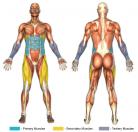Side Knee Raises (Hanging Grip)
- Grip the bar firmly with both hands.
- Lower the arms until they are in the down position with a slight bend at the elbows.
- Rotating at the waist, point both your knees to the left or right (depending on what side you are working out) or alternate directions (not recommended) after each repetition.
- Bend your knees as much as possible, basically to the point that the heels of the feet touch the glutes.
- While keeping the upper body stationary, slowly bring the knees in front of the chest, exhaling throughout the motion.
- Hold this position for 1-2 seconds.
- Slowly bring the knees back down to the starting position, inhaling throughout the motion.
- Switch knee orientation to opposite side (if alternating repetitions were not done).
- Repeat steps 5-7.
It is easy to get into a swinging motion with this exercise, but it's imperative that control is maintained throughout. Keeping a strong grip on the bar will aid in preventing undesired swinging. The upper torso should not be moving at all. Keep all focus on the obliques for movement of the lower torso.
The ideal position of the legs when in the 'up' position is one where your shins are in the middle of the body and your feet and knees are outside of the center. Imagine forming an equilateral triangle where your torso, feet, and knees are the three points.
Exercises involving the abdominal core (particularly the rectus abdominis) call for rounding the back. Indeed, this is likely contrary to advice that you have heard for weight lifting in general, but in the case of exercises that focus on the aforementioned muscle group, rounding the back is recommended to prevent injury.
As with other abdominal/core exercises, the ideal repetitions per set will generally fall within the 25-100 range.
To substantially increase the difficulty, perform the raises with straightened legs. This will greatly increase the difficulty, and consequently far fewer reps will be feasible. This is okay because the intense challenge this variation offers is well worth the loss in reps. The full motion involves moving the legs from a dead hang all the way until they reach the bar (between the gripped hands).





